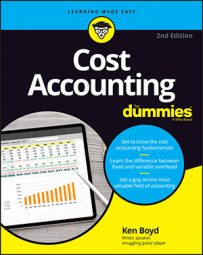In cost accounting, equivalent units are the units in production multiplied by the percentage of those units that are complete (100 percent) or those that are in process. That covers everything.
If a unit is completed and transferred out, it’s 100 percent complete. Now, that may seem obvious, but it’s a point that gets lost when accountants start this analysis. Your approach to complex analysis should be to account for the easy stuff first. The completed and transferred out units are easier to address than work in process.
Say you’ve mixed enough sugar to make 600,000 units of candy. Assume that ending work in process is 25 percent complete for all components of production (material, labor, and overhead). The table below shows the computation of equivalent units.
| Units | Complete | Equivalent Units | |
|---|---|---|---|
| Completed and transferred | 600,000 | 100 percent | 600,000 |
| Work in process, ending | 600,000 | 25 percent | 150,000 |
| Equivalent units | 750,000 |
Although 25 percent of the units are unfinished, in “equivalent unit talk” you can treat them as 150,000 completed units. Add them to the really completed units to get 750,000 units, which represents the number of equivalent whole units you have produced. It’s a lot easier to talk about a whole unit than some whole units and some partially completed units.
The next step is to compute the cost per equivalent unit. Take the total costs of $101,800, and divide by the number of units. Remember that the total costs are the sum of the beginning inventory cost ($48,000) and the costs added during production ($53,800):
Cost per equivalent unit = total costs ÷ number of units Cost per equivalent unit = $101,800 ÷ 750,000 Cost per equivalent unit = $0.1357
The calculation goes to four decimal places, because when you’re making candy that sells for 20 cents per unit, and you’re producing hundreds of thousands of units, every tiny fraction of a dollar counts.
Now assign the cost per equivalent unit to the completed work and the WIP. The table below shows the calculation (costs are rounded).
| Units | Cost/Unit | Cost Assigned | |
|---|---|---|---|
| Completed and transferred | 600,000 | $0.1357 | $81,440 |
| Work in process, ending | 150,000 | $0.1357 | $20,360 |
| Equivalent units | $101,800 |
You’ve assigned costs to both completed work and WIP. Congratulations! Maybe you should eat a pound or two of candy to celebrate.

